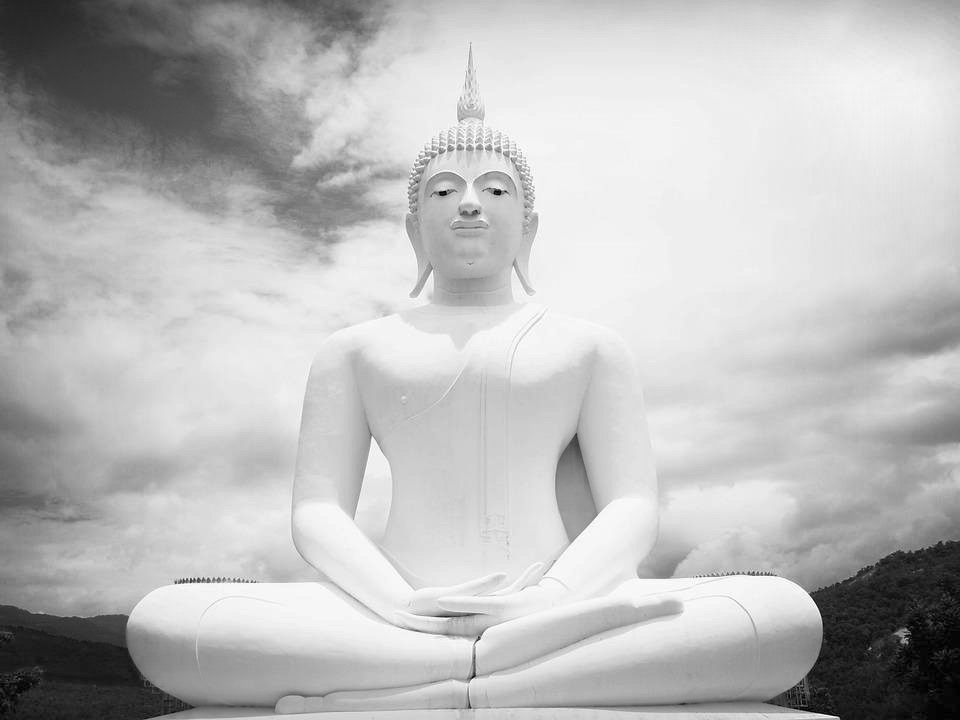
There are those who have Wrong View arising in the dangerous and harmful part of the mind that greedily reaches after those things it hopes can guarantee lasting happiness. There are also those few who do not want to ignore the bare facts of existence, who are not ignorant and deluded by bodily and mental wrong view, who are not deluded by vain hopes and false dreams, who come to see the mind in terms of two parts through insight meditation.
There is always a part of the mind that is aggressively selfish, believing it can have anything it wants. And there is a part of the mind that can stand back and observe and analyze what the egocentric, obsessed, energy-consumer of the mind is selfishly capable of in trying to wrest what it wants from a world—which it sees through a delusional passion-crazed haze of false perception.
The positive part of the mind, which observes and analyzes with detachment, sees with dissociation and disenchantment that selfish, worldly, energy burning and grasping is not the right path to follow because it always results in the same unsatisfactory, disappointing sense of “dis-ease.” In other words, a lack of ease-and-comfort; a lack of fulfillment, followed by dissatisfaction and disappointment.
The part of the mind that stands back and observes can be called the Mind Watching the Mind, which might be said to be morally and analytically one step ahead of the part of the mind that is called The One Who Knows—the one who knows, even if only furtively, secretly, that which no one else knows, such as when one is telling a lie or subversively wishing harm on another or selfishly committing an action at the expense of others.
The mind watching the mind acts based on the observations of the one who knows, who inherently feels a sense of shame and blame. Eventually, the reactions and actions resultant from the mind watching the mind begin to become less shameful and blameful, and more morally beneficial. So, as one begins to feel positive results, one attempts to maintain and to continue to nourish this cause-and-effect process for the sake of the benefit it brings.
This stand-back-and-watch part of the mind is present subliminally, even in the most common, worldly people, but only so faintly and only so vaguely illuminated that it usually remains hidden and little-developed. In the case of most conventional people, it is pushed, unconsciously, back into the deep, dark hidden recesses of the cavernous, unexplored realms of the mind. This is because the pleasure-seeking psychophysical part of the mind just doesn’t want to know, just doesn’t want to see, because it so strongly wants to believe that it is a permanent, abiding individual; a permanent self capable of satisfying the six senses forever.
Such a form of self-delusion obviously serves as an obstacle to clear seeing and the development of moral virtue. Such an ego-centered mind, firmly fixed in worldly pleasure and self-satisfaction, is not aware when it is subconsciously ignoring and blocking out an inherent sense of moral responsibility for any negative consequences that may arise from its intentions and actions—now or in the future—because of its shortsighted and morally clouded, grasping, clinging nature.
“Nature” is the word, and, indeed, “the hidden ignorance” in human nature goes deeper than we have mentioned. There are more coarse and even deeper crude, insidious, hidden levels of the mind that are potentially harmful and damaging, and which can possibly emerge and turn into volatile and even violent action. There are treacherous, unconscious, and savage motives embedded deeply in the human mind that normally do not arise into consciousness to become overt actions, especially within civilized socio-cultural surroundings.
We must, however, through gradual insight, through observing the tendencies of the deep, dark, hidden parts of the mind, eventually realize and come to know the unwholesome part of the mind that is based on blind, primitive, potentially destructive, compulsive, explosive impulses. It arises out of the deepest destructive primordial urges, flowing from sources within the mind’s subterranean gorges.
To use a simile: one must approach the brutes and demons within the mind and try to round them up and break them in, like wild beasts, similar to the way in which, during the time of the Buddha, a king’s gamekeeper might have caught and tamed wild elephants and horses. One must approach the brutes and demons of one’s own mind and try to catch and break them in to the point at which one is eventually able to subdue and train their potential energies to become less dangerous and more focused, more useful and beneficial.
We would be deluding ourselves if we did not admit that the mind has such unrefined, ugly, nasty, brutish, perverse, pernicious, intractable, primitive sides. And, comparatively speaking, to use another simile: they lurk in the mind like sparks, almost invisible, like fireflies, seen and unseen, in the dark of night, which might, dependent on arising conditions, be capable of igniting potentially harmful, explosive energies and forces. They lurk there like ghastly, grisly, ghoulish spooks and naughty, impish, mischievous sprites in the clouded gloom of the untrained mind.
Such untamed forces may be likened to unseen jungle creatures, being metaphorically sought out and either dragged and brought, leashed and led out of the darkness and into the light. Much as one might observe a band of wild monkeys being lured out of the jungle, scrambling along the top of a wall leading up to a temple into the clear open light of day, and then being gathered and inspected and admonished, and then patiently trained and gently calmed, carefully cultivated by the powers of a skilled meditative instructor, so as to eventually become tamed and trained and harmless.
To reiterate, we must arouse ourselves to penetrate into the dark, to seek out and locate those hidden, dangerous, primitive sparks of potentially explosive energy located within the deepest, darkest recesses of the caverns of unconsciousness. They can then eventually be brought out and exposed and examined under the bright light of analysis, and so persistently inspected, observed, admonished, and blamed, or so well cared for and loved, tamed and trained that they lose their aggressive power and become calmed. Eventually they will be so sorted out and balanced that they finally either work in harmony with the mind, or they slink away in shame, cleverly knowing, as the kilesas (Pali. defilements) always do that they have been seen and recognized for what they are—the dark siblings of Mara—in the light of right understanding, against which they have no defense.
Battling such wild powers of the mind sounds courageous and echoes of mighty warriors, but the problem remains that in our present world so far from the Buddha’s time, there are, unhappily, only few meditation teachers and practitioners who are able to strive to purify and liberate themselves, either wholly or partially, from the ever-pervasive and deep-seated, unwholesome, agitating impulses, attachments, and entanglements within the jungle of the defilements down deep within the worldly mind.
If it is difficult for the few “with little dust in their eyes,” then what about the rest of us? How do we begin to untangle the tangle of the worldly world as it becomes ever-more entwined within our own society and within our own minds?
Related features from BDG
Within Chaos, There Is a Refuge for Meditation
About Right Concentration
Silence












